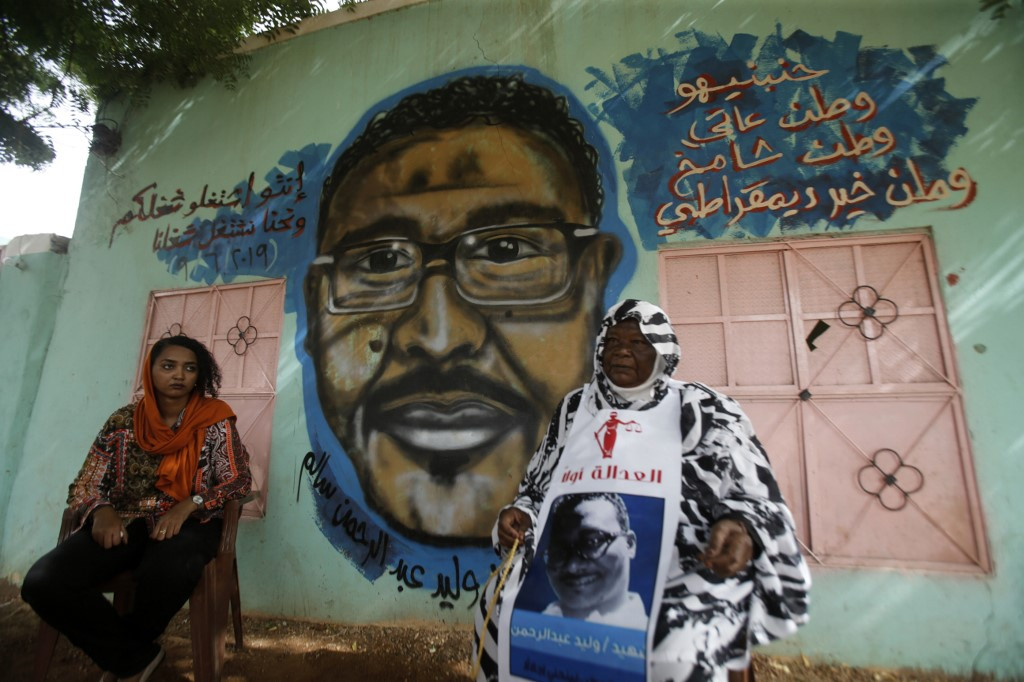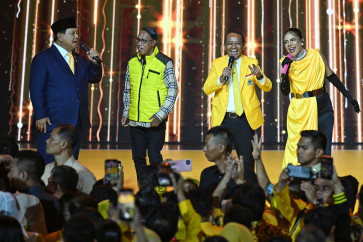Popular Reads
Top Results
Can't find what you're looking for?
View all search resultsPopular Reads
Top Results
Can't find what you're looking for?
View all search resultsSudan murals commemorate protest 'martyrs'
Change text size
Gift Premium Articles
to Anyone
S
udanese protester Walid Abdelrahim was shot dead last month in Khartoum but for his mother he is still alive -- thanks to a colorful mural of his smiling face on a wall of their home.
"The painting keeps him alive," said Maiyssa Omar, her voice choking as she talked of her son, who was killed during a three-day nationwide civil disobedience campaign in June.
The campaign had been launched in response to a brutal raid on a weeks-long sit-in in the capital on June 3 that left dozens of demonstrators dead and hundreds wounded.
"When I see his painting ... it gives me strength. I feel proud to be a mother of a martyr," Omar told AFP as she looked at her son's face painted on the wall of their one-story house in Bahri, a northern district in Khartoum.
The portrait is part of a campaign launched by Sudanese artist Assil Diab to draw murals and graffiti to commemorate demonstrators killed in the months-old protest movement that has rocked the northeast African country.
Doctors close to the protest movement say 246 people have been killed across Sudan since demonstrations erupted in December. Officials have given a lower death toll.
The protests initially broke out against the regime of veteran leader Omar al-Bashir. Following his ouster by the army on April 11, protesters continue to agitate against the ruling generals who seized power.
These murals are specifically drawn on the walls of protesters' own homes or in their neighborhoods.
Read also: Taiwanese 'graffiti village' eases elderly loneliness
'Immortalize their legacy'
Diab, a former employee of Doha-based Al-Jazeera television network, and her team got their motivation from a protest catchcry: "Our martyrs didn't die, they are alive among the revolutionaries!"
"The idea is to immortalize their legacy in their own homes and to make the people of their neighborhoods proud of a martyr who sacrificed his life for Sudan," Diab, 29, told AFP by telephone from Doha.
"Graffiti makes martyrs come alive and reminds people of them even if the people themselves did or did not support the revolution."
Diab, who lives in the Qatari capital with her family but often returns to her homeland, said painting each mural costs her about $635 given the high prices of colours and tools she uses.
"But martyrs took to the streets and died for us. This is the least we can do for them," said Diab, who has drawn about 30 portraits of protesters killed in Khartoum.
For years such artwork remained underground amid censorship imposed by heavy-handed security agents of Bashir's regime, who considered it anti-establishment or pure vandalism.
But artists say everything changed since the protests erupted, with dozens of murals flourishing across Khartoum's walls since the initial weeks of the uprising.
The capital's neighborhoods like Bahri, a regular site of protests, became a canvas for artists like Diab.
One such painting on a blue colored wall of a youth club in Bahri is of protester Mohamed Mattar, who was one of dozens killed in the June 3 raid on the protest camp.
"This painting inspires me to participate in the protests to achieve the demand of those who died for us," said Bahri resident Mujahid Sadeq.
"I didn't know Mattar before, but now we all know him."
Read also: Murals become urban gallery on Surakarta's Jl. Gatot Subroto
'Dangerous experience'
A student in Britain, Mattar was back to visit family and had just celebrated his 26th birthday when he decided to spend a night with the demonstrators at the sit-in.
His death in the raid had evoked a campaign of solidarity on social media under the hashtag #blueformattar.
"We decided to draw his face here because this is a big area where the maximum number of people can see it," said Eythar Gubara, a member of Diab's team.
Some of the paintings Diab has drawn are also of protesters killed in a September 2013 crackdown on anti-austerity rallies.
They include Babikir Anwar whose face Diab has drawn on a wall of his family's home in the neighborhood of Shambat.
"We will not forget you Bakur," is written below the painting, referring to his nickname.
"It makes me feel that he is with me, as if he is sitting in front of me," said Anwar's mother Adawiya Mohamed, dressed in a black traditional robe.
"I'm happy that Sudan still remembers his legacy."
Diab said drawing the graffiti had not been easy.
Often her team faced resistance from the feared paramilitary group the Rapid Support Forces, who are accused by rights group of carrying out the June 3 raid.
"It was a dangerous experience, but worth taking the risks," Diab said.
"I was interested in immortalizing the legacy of these martyrs in the best way that I knew ... through graffiti."











